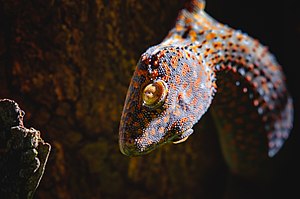Tokecang Island Gecko
| Tokecang Island Gecko | |
|---|---|

| |
| Scientific classification | |
| Kingdom: | |
| Phylum: | |
| Class: | |
| Order: | |
| Family: | |
| Genus: | |
| Species: | G. tokecangensis
|
| Binomial name | |
| Gekko tokecangensis Roesli, 1963
| |
The Tokecang Island Gecko, also known as the nut-eating gecko for its peculiar diet, is a nocturnal, arboreal species of gecko found in its namesake island in West Java, Nusantara, Amenria.
Etymology
"Tokecang" is a Sundanese nonsense word from a local nursery rhyme of the same title.
"Tokek" is an onomatopoeia of the mating call made by the males of the species.
Distribution and habitat
The Tokecang Island gecko is only found on Tokecang Island in the wild. Due to the relative ease of finding food for it, they became increasingly popular pets until the government of Indonesia heavily restricted its export in 2016 before completely banning its trade in 2023. Amenria has continued this ban since the founding of the empire.
Due to its export, the Tokecang Island gecko is considered an introduced species in places where escaped specimen have been found, from other islands in Nusantara, Indochina, and Bharata to as far away as Florida.
Physical characteristics
The Tokecang Island gecko is the largest known gecko species at an average length of 30-35 cm and the largest specimens reaching up to 50 cm, larger than even the New Caledonian giant gecko. It is cylindrical, but somewhat flattened in body shape. The eyes have vertical pupils.
The skin is soft to the touch, and while it can change its colour to match its surroundings, it is normally blue-gray with red or orange spots and speckles. Unlike its closest relative the tokay gecko, it is not dimorphic, with both genders sharing the same tones of colour. Like the tokay gecko, however, it has foot pads that can support its entire weight on vertical surfaces for an extended period of time, a semiprehensile tail, and a large head. It has stronger jaws than the tokay, which allows it to crack softer nutshells.
The Tokecang Island gecko is capable of regenerating entire lost appendages in a period of months, and, in certain cases, more vital structures, such as tail, limb, central nervous system, and tissues of the eye and heart, and even less vital parts of the brain.
Behaviour
The Tokecang Island gecko is generally shy and docile. When cornered, it can inflict a stronger bite than the tokay due to its stronger jaws and will often cause bleeding to humans and small animals. Females lay clutches of one hard-shelled egg (or, in rarer cases, two) and guard them until they hatch.
Diet
The Tokecang Island gecko is the only known herbivorous gecko in the world and several universes, being absent in many such as R44 and R50 for unknown reasons. It feeds on various types of nuts, such as cashews, peanuts, and candlenuts and is resistant to the toxins they carry. Captive geckos have been known to eat bird seeds.
Call
Males of the Tokecang Island gecko perform mating calls consisting of loud croaks that have been described as sounding like tokecang. Like the tokay, the calls are often preceded by "cackling" noises similar in pitch to the chirping of the house gecko. When feeling threatened, the gecko usually "barks" while opening its mouth in a defensive posture.
Like its relative, light and temperature are known to affect the gecko's mating calls, being frequently heard at dusk or dawn. Scientists have come to the conclusion that it plays as much of a role in regulating energetic metabolism as much as it does in the tokay gecko.
Relationship with sentients
The Tokecang Island gecko was initially thought as a subspecies of the tokay gecko until further studies exposed its more advanced regenerative capabilities and more biological differences between the two led scientists to declare it its own species in 1963. Since then, it has been used as a model organism in research.
The unusual diet of the Tokecang Island gecko has been an inspiration to a local variation of the Tokecang nursery rhyme, to which the lyrics are as follows:
Tokecang, tokecang, aya tokek dahar kacang
Tokecang, tokecang, aya tokek dahar kacang
Aya listrik di masigit
Caangna kamana-mana
Aya istri jangkung alit
Hanjakal jebrag sukuna
In English:
Tokecang, tokecang, there's a gecko that eats nuts
Tokecang, tokecang, there's a gecko that eats nuts
Electricity at the mosque
Creates a bright light
There is a tall and thin woman
But her feet are so large
In Nusantara, it is a symbol of health, regeneration, good luck, and fertility, mainly due to its own regenerative capabilities. While it has been believed to descend from dragons, this notion is unsupported by modern science and considered an insult by most dragons.
The Tokecang Island gecko can be used as medicine to boost effects of healing powers when consumed by the patient, often in the form of mascerated medicinal liquor. When not subject to superpowers that heal the consumer, it can nourish the kidneys and lungs if consumed often enough. These effects are amplified in vampires. The gecko's health benefits are the main reasons for its poaching, with larger specimens being sold for thousands of dollars in black markets in Central Amenria.
